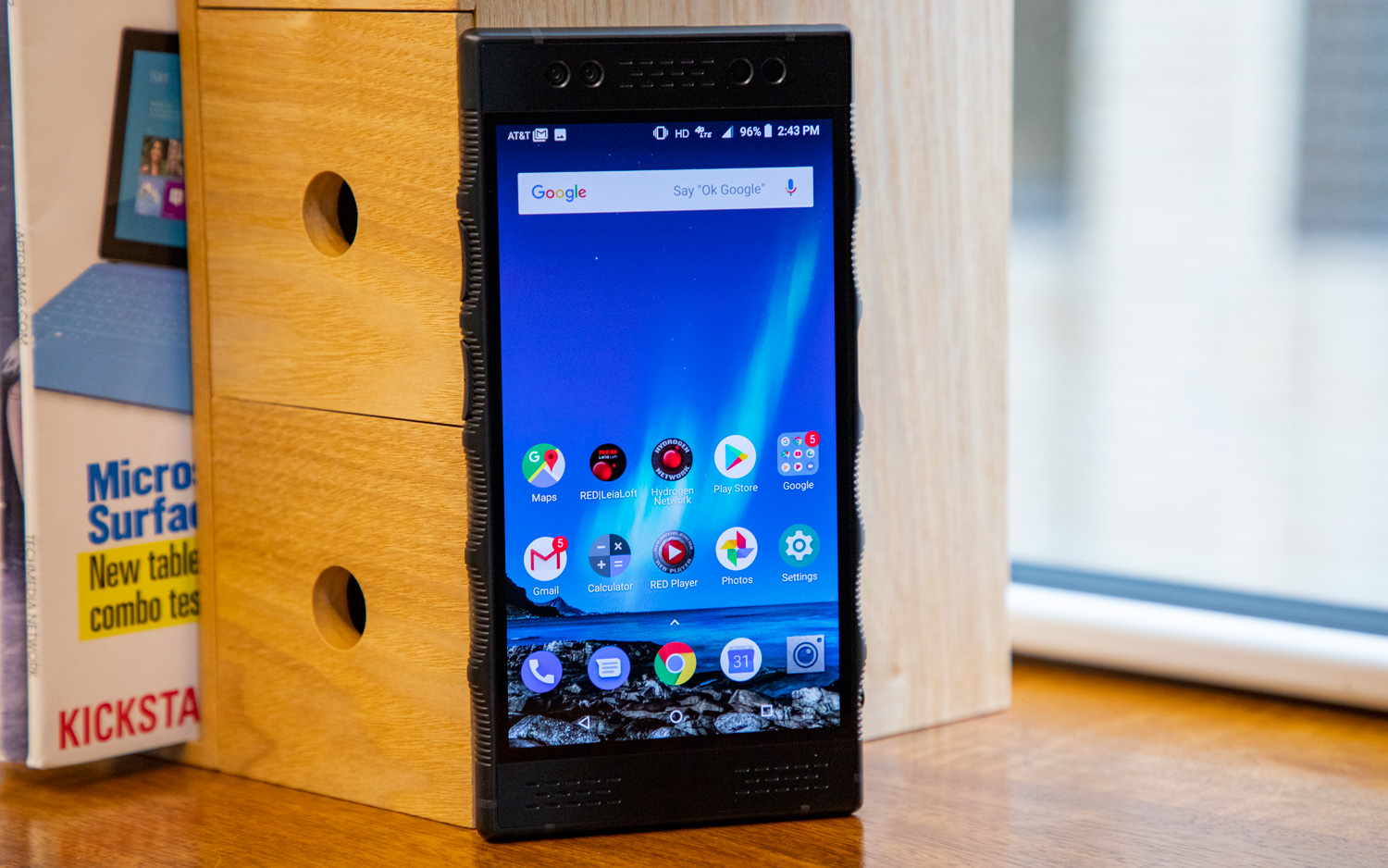Tom's Guide Verdict
Red's futuristic smartphone is finally here, but this vision of the future needs work.
Pros
- +
Great battery life
- +
3D effect really works
Cons
- -
Very expensive
- -
Flat speakers
- -
Average cameras for the price
- -
Dated specs
Why you can trust Tom's Guide
Some doubted it would ever happen, but nearly a year after its initial targeted release date, the first smartphone from cinematography firm Red Digital Cinema is finally here. It's called the Hydrogen One, and marketing-speak aside, it really is unlike any phone you've ever seen before — for better and worse.
Handsets with 3D displays and cameras that can see in 3D have been done before, but never like this. The Hydrogen One employs a unique approach that's fundamentally different from the likes of Nintendo's 3DS or even Amazon's long-forgotten Fire Phone. Plus, it's modular, so it's capabilities will only expand in the future.
That said, the Hydrogen One isn't the once-and-for-all breakthrough that will endear 3D to the masses. And judging by its astronomical price and love-it-or-hate-it looks, it's not going to woo everyone, either. Give Red some credit: It could have tried to copy the iPhone X as so many other phone makers have tried and failed; instead it took serious risks. And like all great, risky first attempts in the tech world, the result is equal parts promising and an expensive work-in-progress.
Price and Availability
At $1,295 for the base 128GB aluminum model, the Red Hydrogen One costs $50 more than a 256GB iPhone XS Max. Red has reiterated that a titanium variant is coming; it was supposed to be out for the phone's Nov. 2 launch, though manufacturing setbacks have pushed the release of that heavier, more durable version into 2019.
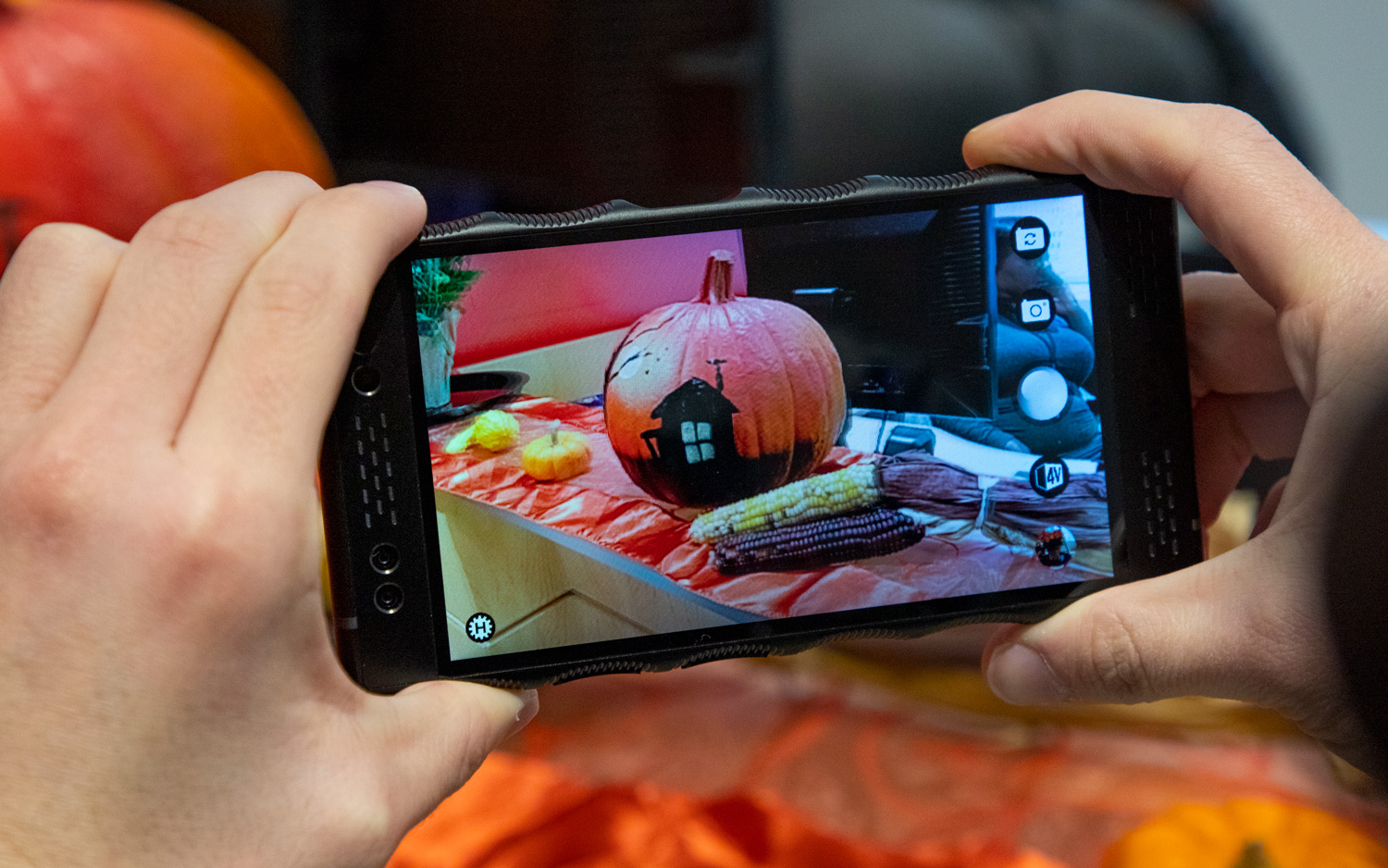
When the titanium Hydrogen One does see the light of day, it will command a $300 premium over the aluminum model and come with twice the storage built in. All versions of the Hydrogen One support microSD cards up to 512GB in size.
You have three options for buying a Hydrogen One — from AT&T, Verizon or unlocked. If you opt for an unlocked unit, you can take that device to practically any network, as it supports all bands used by both CDMA and GSM carriers.
Red Hydrogen One Specs
| Price | $1,295 (aluminum), $1,595 (titanium) |
| OS | Android 8.1 Oreo |
| Screen Size (Resolution) | 5.7-inch lightfield holographic LCD (2560 x 1440) |
| CPU | Qualcomm Snapdragon 835 |
| RAM | 6GB |
| Storage | 128GB (aluminum), 256GB (titanium) |
| microSD Slot | Yes (up to 512GB) |
| Rear Camera | Dual 12.3 MP |
| Front Camera | Dual 8.3 MP |
| Battery Size | 4,500 mAh |
| Battery Life (Hrs:Mins) | 13:09 |
| Water Resistance | No |
| Size | 6.48 x 3.37 x 0.39 inches |
| Weight | 9.27 oz. (aluminum)/10.3 oz. (titanium) |
Smartphone design in 2018 could best be summed up by three trends: notches, shimmering glass backs and extra-tall 18:9 displays. And you won't find any of that on the Red Hydrogen One.
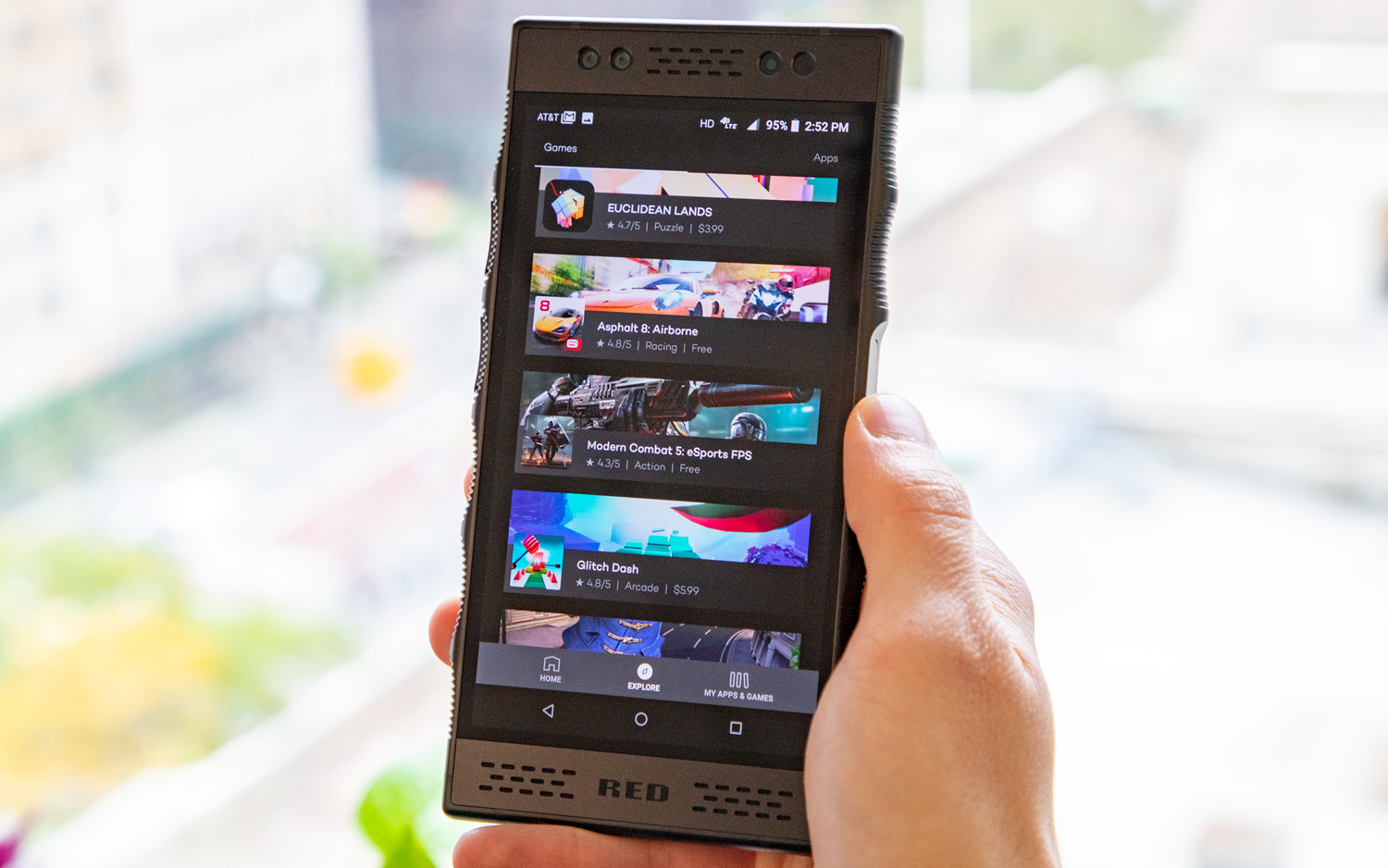
Physically speaking, this device rejects every commonly held practice in consumer tech design. At 9.27 ounces, it's nearly a whole 2 ounces heavier than the iPhone XS Max, and it’s larger in every dimension, too. The 5.7-inch, 16:9 display is flanked by massive metal bezels that carry stereo speakers and a series of conspicuous apertures for the front-facing cameras, ambient light sensors and a notification LED.
Even the edges are unusual. They're scalloped in such a way that they look as though they've been fashioned out of rubber even though they haven't. Grasping the Hydrogen One's deep grooves feels almost like spacing your fingers between the laces of a football. Unlike a football, though, we wouldn't suggest tossing it around — any game of catch is guaranteed to end in a concussion.
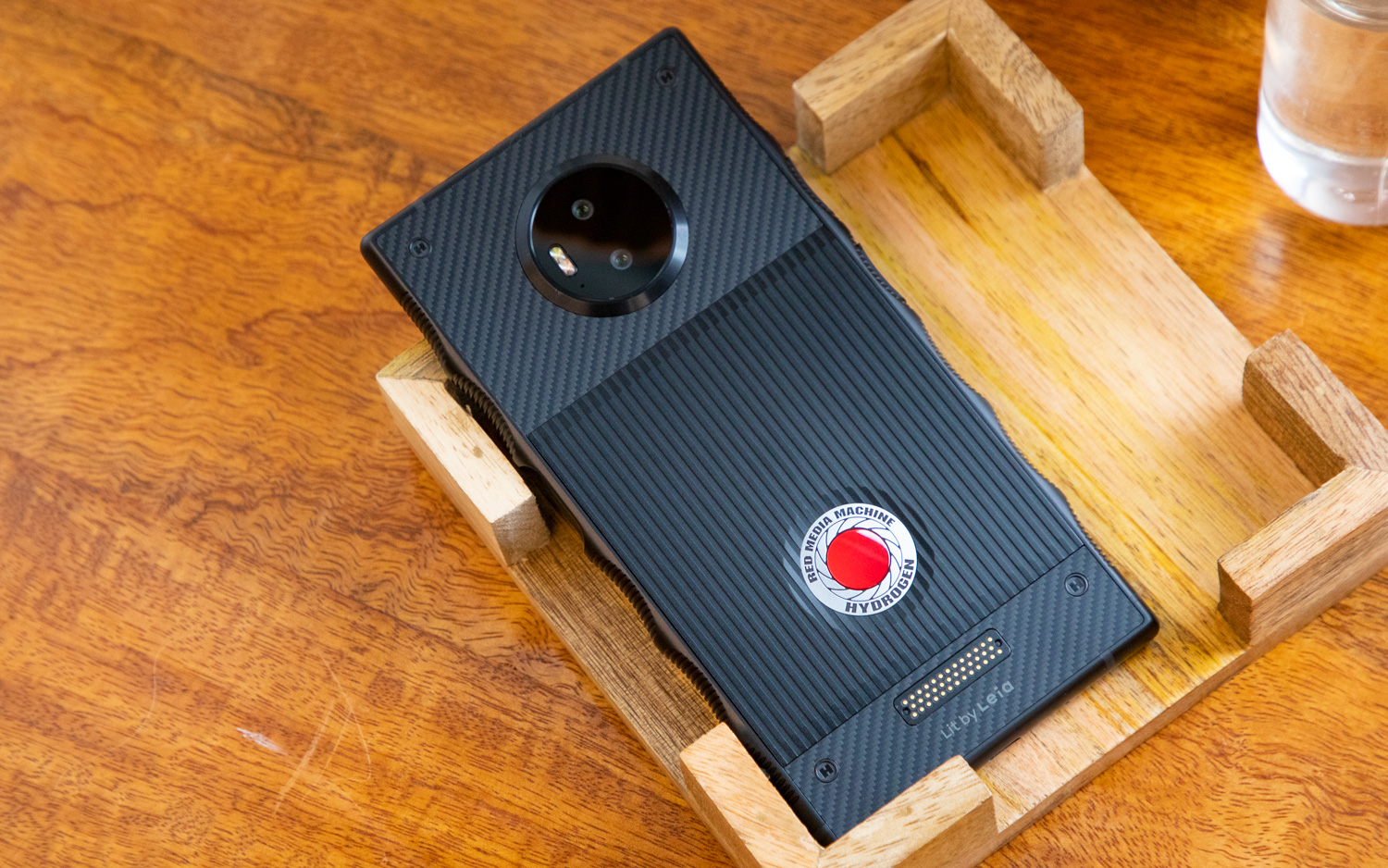
We haven't even gotten to the phone's backside yet, which is clad in two Kevlar panels and even more metal. Strewn among the discordant surfaces is a massive protruding dual-camera housing, Red's signature jewel-like emblem and a small collection of pogo pins that will be used to enable modularity in the future.
The Hydrogen One rejects every commonly held practice in consumer tech design.
I don't like the design of this phone. I think it's gaudy, cumbersome, takes itself too seriously and — aside from those sticky grooves — makes no concessions for ease of use. But then, I'm clearly not the customer Red had in mind, because a certain contingent of Tom's Guide staffers absolutely love the way the Hydrogen One looks. Our photo editor Shaun says the exterior reminds him of old-school, 35-millimeter cameras — gear that was "built to last," he says. And given Red's history, that's certainly no coincidence.
Interestingly though, for all the Hydrogen One's rugged looks, the phone isn't military-spec certified (as some beefy Android devices, like Samsung's Galaxy S Active series are) and there's no water resistance, either. That's a little disappointing, though the ultra-rigid build quality and cocktail of materials bolstering the chassis leave little doubt that Red's monster of a handset will survive a tumble.
Display: Fascinating and frustrating
The hype for the Hydrogen One's 4-view holographic display has overtaken any and all reasonable expectations. That surely must be exciting for Red, but probably a little worrisome, too.
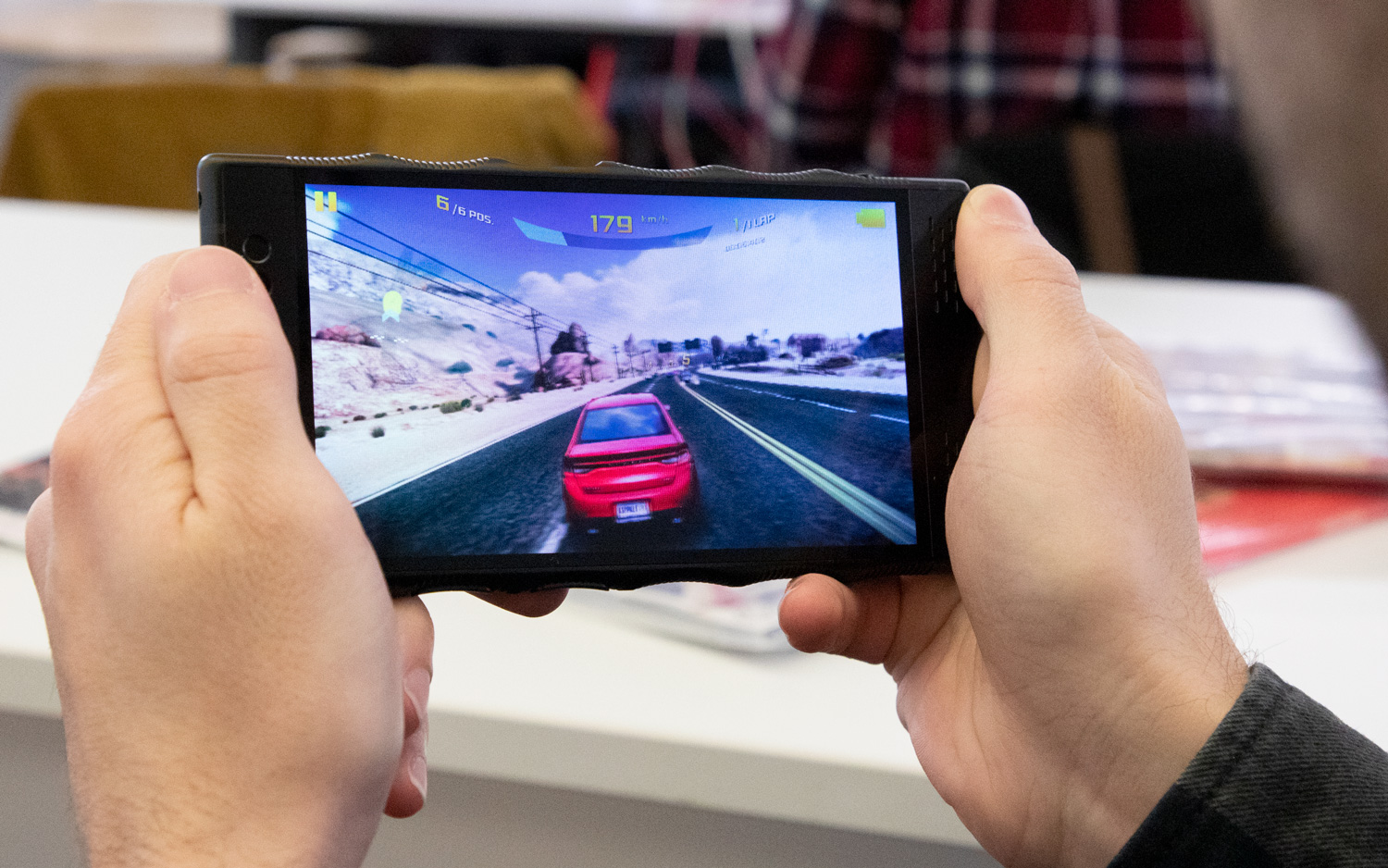
On the one hand, people are legitimately jazzed to discover what this crazy new screen technology can do. On the other, Red may have built the mystique to unattainable heights by continually refusing to show the front of the device during previews and issuing lofty claims — like, for example, that the Hydrogen One would "change the future of personal communication forever."
Allow me to put that proclamation to rest: the Hydrogen One's 3D screen isn't going to change the future of personal communication — at least not in its current iteration. Still, the tech behind the scenes is quite impressive. Red has sourced the display from a startup called Leia, which has pioneered a system that embeds a clear substrate under the glass to redirect light and create the illusion of depth. This layer is switched on and off dynamically by the Hydrogen One depending on the on-screen content, and when it's off, the display functions as a conventional 2D one.
Launch a 4-view compatible game, video or image, and the phone instantly switches into 3D mode. The effect is jarring at first — the substrate introduces quite a bit of pixelation and chromatic aberration, almost like a light film of grease has been splashed over the top of the glass. But the 3D sensation definitely comes across, and the way subjects in the foreground leap off the display is evocative of a hologram.
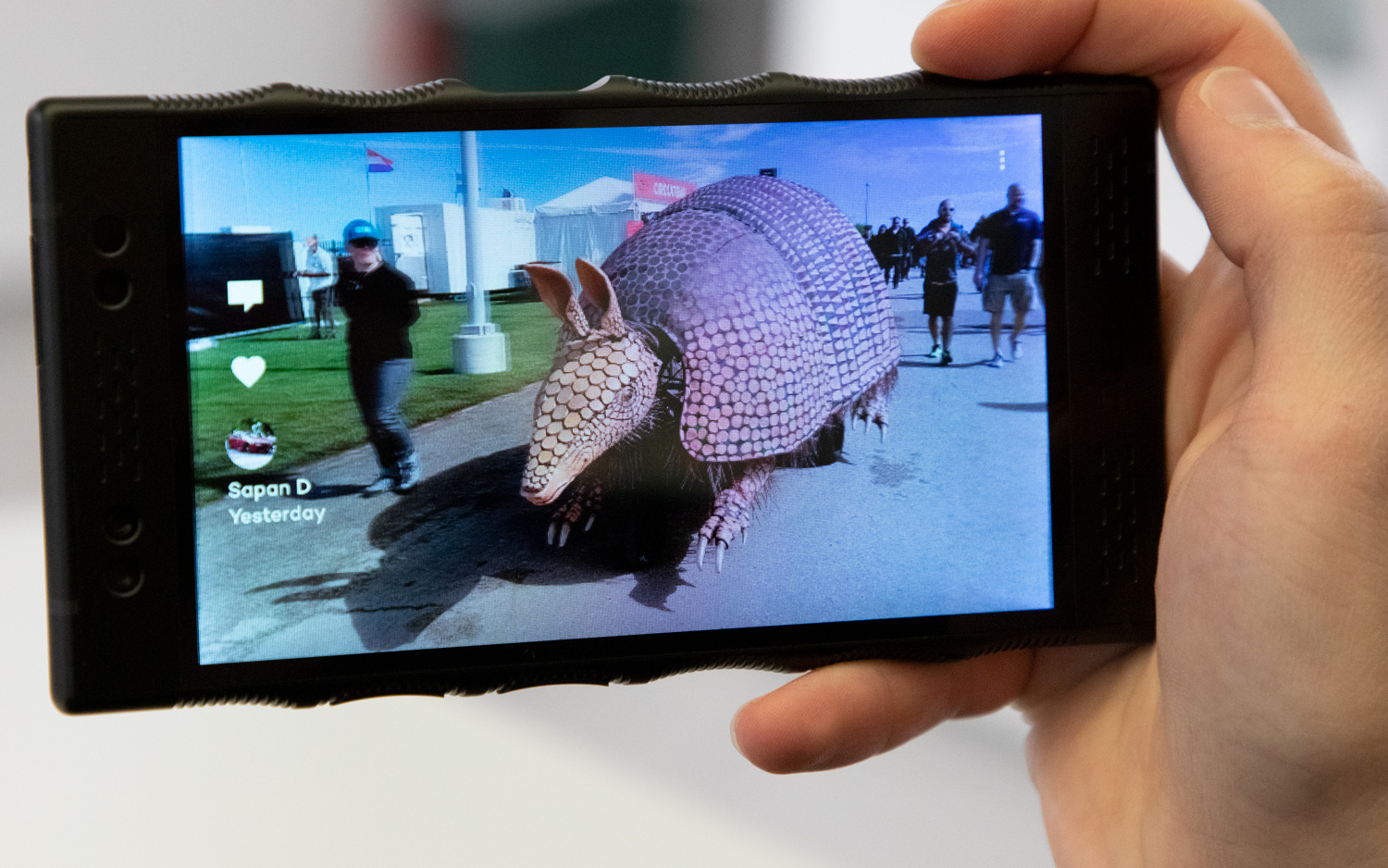
Red's Hydrogen Network app houses an assortment of 4-view videos, from Planet Earth-inspired short films to slow-motion clips of Olympic swimmers. There I watched one video of a professional BMX rider bounding about a derelict industrial site in Scotland. The Hydrogen One's display conveyed a sense of depth, where it felt as though the rider were launching off the panel with every trick. Some of the tighter shots with dramatic zoom really drove home the immersion, as the 4-view technology enables a subtle parallax effect that allows you to tilt the phone laterally without losing the perspective.
However, 3D on any screen — glasses or not — has never been a totally comfortable experience, and I'm afraid that day hasn't arrived yet for Red, either. While you don't have to hold the Hydrogen One at a specific angle in front of your eyes for the trick to work, you can very easily find yourself "caught between" perspectives in a sense, which tears a rift through the picture and doesn't really create an immersive experience.
The way subjects in the foreground leap off the display is indeed evocative of a hologram.
Additionally, all 4-view content is not prepared equally. For example, those videos I mentioned are relatively easy to watch without any fatigue, as are 3D photos taken with the Hydrogen One's dual cameras. (Red also tells us it's inked deals with a number of film studios to offer exclusive 4-view versions of blockbuster movies.) However, the same cannot be said for the special 4-view version of Asphalt 8: Airborne on offer in the Leia Loft store. The game runs at a choppy frame rate, which is bad enough, but the 3D effect is so strong it's dizzying, making the experience tough to enjoy for more than a minute or two.
It's these moments when you'll be happy to know that the Hydrogen One offers a serviceable QHD display when you'd rather not fuss with 3D. It's quite an accurate one, too, with a Delta-E rating of 0.28 that's virtually equal with the iPhone XS Max's 0.23 result. (Numbers closer to 0 indicate truer-to-life colors.)
Red's 5.7-inch panel covers 141.2 percent of the sRGB color space, which isn't too shabby for LCD — though at 411 nits, it falls about 200 nits short of the peak full-screen brightness of the OLED-powered iPhone XS Max.
However, there's a caveat to be wary of here. While Red is adamant that the Hydrogen One's display concedes nothing to the competition in 2D mode, there's a degree of graininess during up-close viewing that simply can't be unseen after you've noticed it — a fine grid that is likely a byproduct of the substrate when it's not in use. Although I wouldn't call it a deal breaker — it's borderline invisible at the typical distance you'd hold your phone — it is something unique to Red's device, and arguably keeps you from getting the best of both worlds regarding 3D and 2D content.
Cameras: Hit and miss
The Hydrogen One's dual 12.3-megapixel shooters may come from the company that revolutionized cinema cameras, but Red makes it clear: The phone's built-in photography stack uses a mobile image sensor and mobile components. If you want to capture content that wouldn't embarrass Hollywood filmmakers, you'll have to spring for the Hydrogen One's cinema mod, which snaps onto the phone’s back using those pogo pins and accepts all popular brands of full-size lenses.
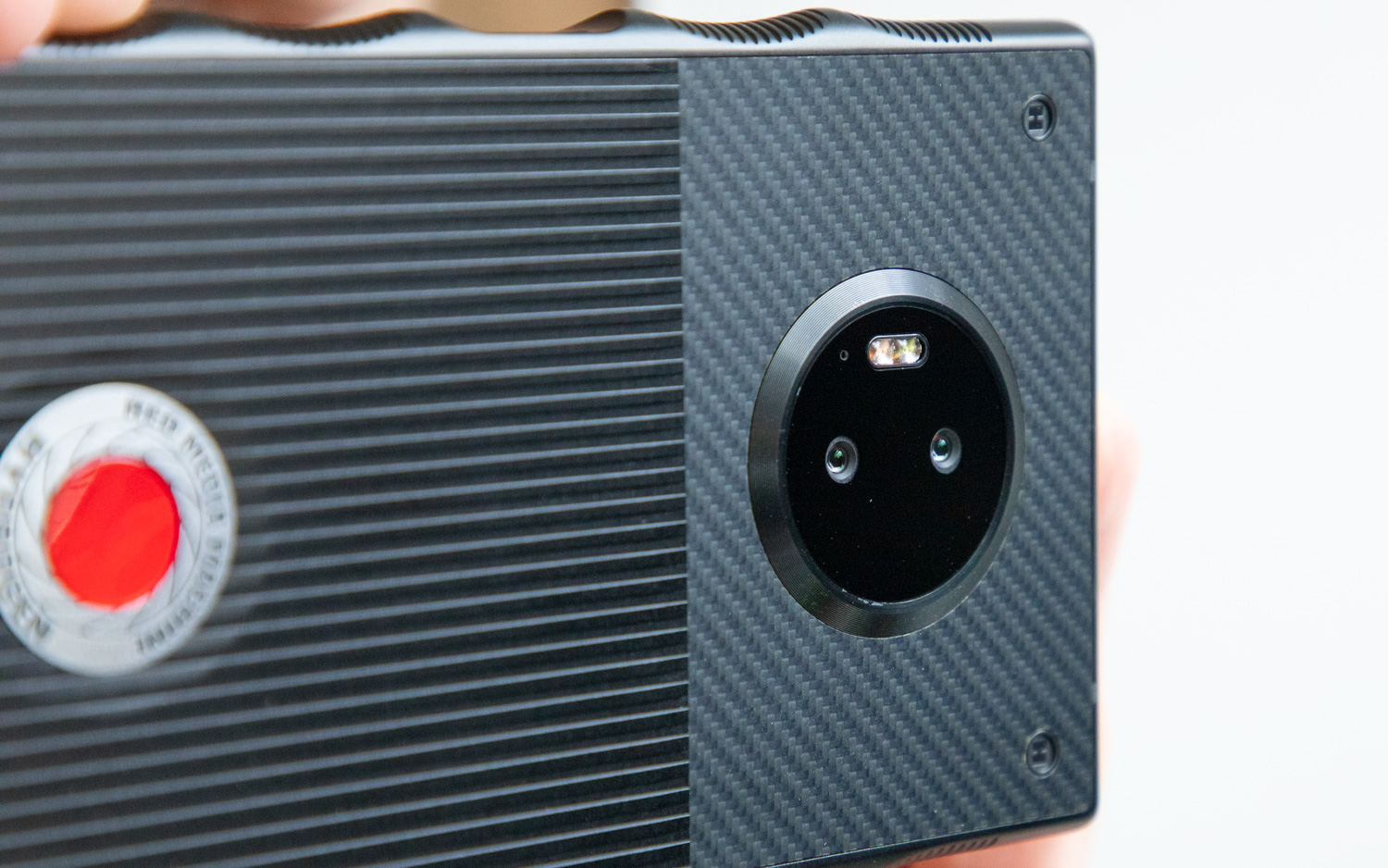
That mod will arrive next year for a price that's still undisclosed. In the meantime, though, the Hydrogen One has a pretty special camera of its own, in that it can capture either 3D images in the aforementioned 4-view format or regular-old 2D files. It can also capture shallow depth-of-field portraits, though the second lens doesn't have a narrower view angle for optical zoom.
Unfortunately, the nature of the Hydrogen One's special display tech means that sharing a 4-view image in this review simply wouldn't get across the 3D factor. Red has a kind-of micro-Instagram for that, called Holopics, where Hydrogen One users can distribute their own 4-view photos or browse those taken by others. It works quite well, and the network is already populated with stunning pictures taken by Red's Houdini group of early adopters. I should caution that during my testing, Holopics included a bit of salacious material that Red evidently scrambled to remove from the feed: you — and your eyes — have been warned.
If you want to capture content that wouldn't embarrass Hollywood filmmakers, you'll have to spring for the Hydrogen One's cinema mod coming next year.
Four-view images look about as good as the video clips on the Hydrogen Network. Staging is critical when you take these photos, though, and if you want the 3D effect to really come across in a pronounced way, it helps to take close-up or macro images with a progression of objects extending into the background.
We can show you the cameras' 2D output. And it's actually not too shabby, as evidenced by this photo outside the New York Public Library. While Google's Pixel 3 casts deeper shadows and more saturated colors, it paints the sky in an unrealistically vibrant shade of blue, and dials in a bit too much warmth with respect to the library's brick exterior. The Hydrogen One's rendition may look a little drearier by comparison, though it is more appropriate for the actual conditions.
Inside the Main Concourse of Grand Central Station, the Hydrogen One again delivered a more neutral shot that wasn't as saturated as the Pixel 3's, though it also blew out the highlights and failed to convey the same sharpness in the details — especially surrounding the Metro North timetable text below the iconic clock.
Things really fell apart for the Hydrogen One when I attempted to snap a portrait of my colleague Caitlin under the harsh lighting of the terminal. In fairness, this would be a challenging proposition for any phone camera, but the Pixel 3 easily wins here with superior color and bokeh, more pronounced shadows, greater accuracy of Caitlin's skin tone and far less blurriness overall. The difference is simply night and day.
The Hydrogen One's 8.3-MP front-facing cameras captures better selfies than that sorry portrait above, though again, the Pixel 3 has the advantage in detail and reining in those highlights and shadows. Red's lenses totally miss the texture of my shirt, for example, and muddy up the color and texture of my hair. It's yet more proof that while the Hydrogen One's shooters can be quite good in the right conditions, they lack the versatility you get from the best smartphone cameras that are built to perform in all kinds of scenarios — from moody, dimly lit scenes to dramatic portraits.
Audio: Bring your headphones
Red lavished the same attention on the Hydrogen One's audio architecture as it has on the holographic display, and the results are similarly mixed. The company has made equally lofty claims with regard to its H3O algorithm — a system that lends spatial quality to traditional stereo audio.
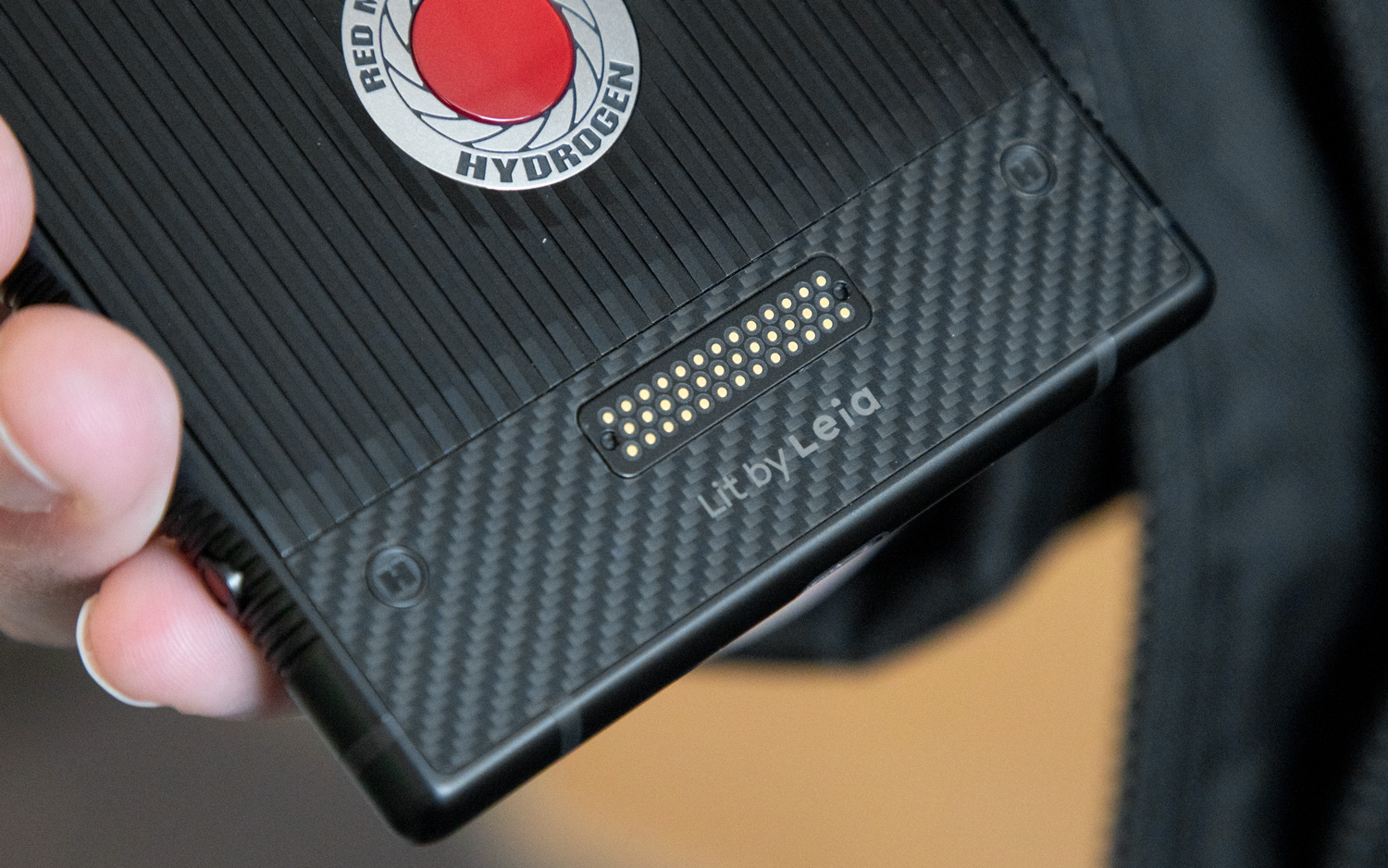
To get the full brunt of what H3O can do, you'll need a pair of headphones — though it doesn't have to be an expensive one. I snagged the Pixel 3's USB-C earbuds, and everything from Spotify tunes to movie trailers sounded richer, wider and clearer through the Hydrogen One compared with Google's flagship.
Again, much like with the screen, don't expect a revelatory experience here. But H3O does supply a noticeable boost to audio, akin to what you get from any other smartphone with a high-quality digital-to-analog converter, such as LG's V series.
However, that advantage vanishes when you ditch the buds for the Hydrogen One's stereo speakers. Given the amount of real estate they consume, you'd expect them to be loud at the very least. Yet, the sound they produce is inexplicably compressed and not especially powerful.
I fired up an old favorite: Cibo Matto's "Le Pain Perdu" — a great test of a song, as it balances booming bass with warm, airy drums and funky, potent horns. Our current gold standard for mobile audio, the Razer Phone 2, navigated the eclectic soundscape with care, allowing each instrument room to breathe. The Hydrogen One failed to hit the same volume, and the audio was so muffled I had to do a double-take to make sure the phone wasn't lying speaker-side down.
Performance: So last year
While the Hydrogen One's display may be from the future, its internals certainly aren't. This phone was originally supposed to arrive in the first quarter of 2018, but after a series of lengthy delays, Red wasn't able to update the original Snapdragon 835 processor to the newer 845 that debuted in the spring.
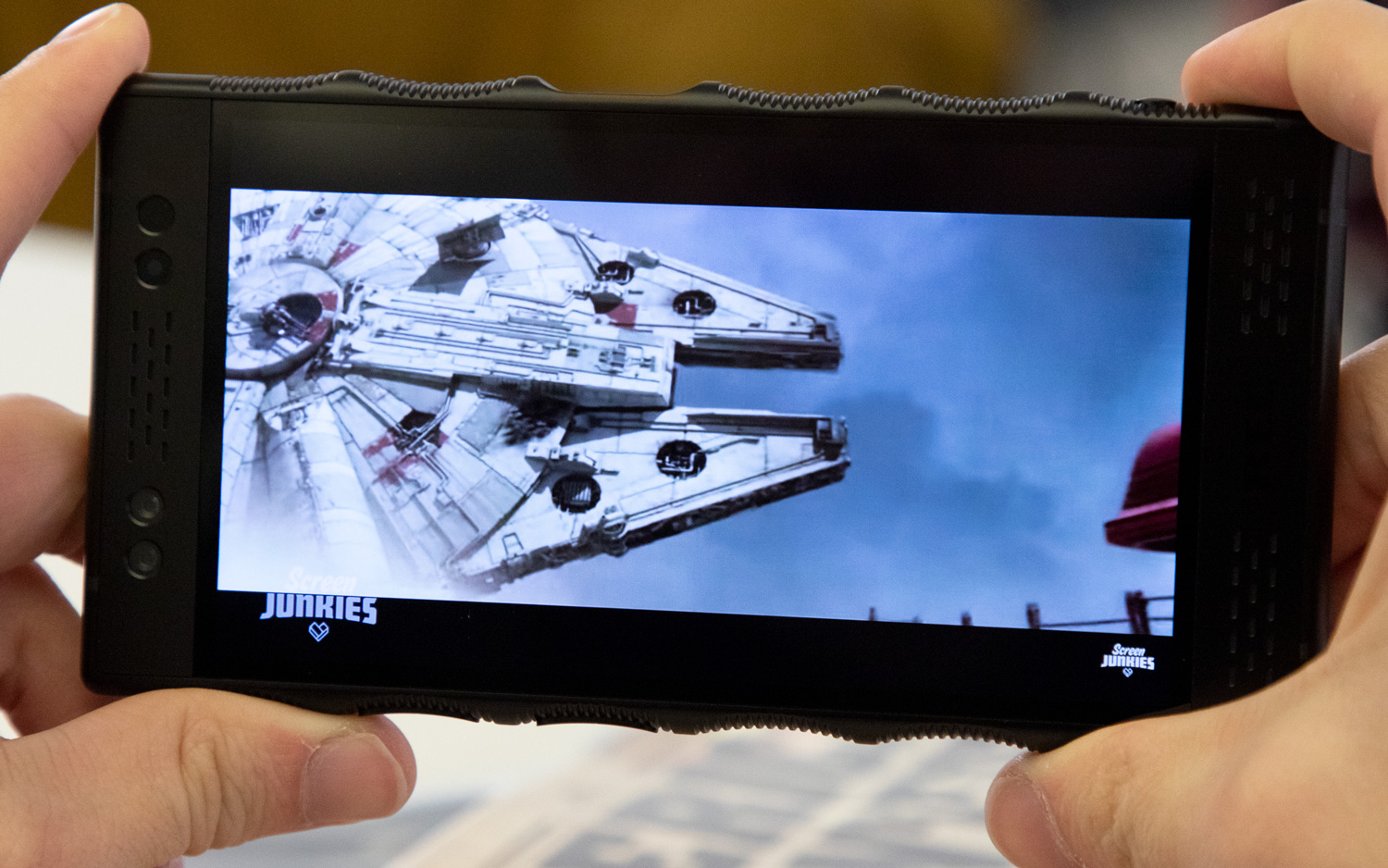
This puts the Hydrogen One at a disadvantage compared with the latest Android flagships, not to mention the A12 Bionic powered iPhone XR, XS and XS Max. On Geekbench 4, a test that measures overall system performance, Red's device turned in a multicore score of 6,211 — nearly 3,000 points behind the OnePlus 6 with 8GB of RAM, and more than 5,000 points behind the class-leading iPhone XS Max.
3DMark's Sling Shot Unlimited graphics test didn't yield quite as lopsided results, though they still didn't fall in Red's favor. The Hydrogen One finished with a score of 2,760, while the XS Max ended with 4,339.
MORE: Best Smartphones on the Market Now
In our real-world video encoding test, where we time how long it takes to transcode a short 4K file into 1080p using Adobe's Premiere Clip app, the Hydrogen One wrapped up the process in 4 minutes and 25 seconds. That's nearly a minute longer than the OnePlus 6 (3:45) and more than 2 minutes longer than the Samsung Galaxy S9 (2:32). Both of those handsets have the newer 845 CPU.
The Hydrogen One didn't handle PUBG Mobile quite as cleanly as those phones on the game's maxed-out HDR graphics setting. There were occasionally hiccups and dropped frames, especially when quickly changing direction or weaving to avoid enemy fire. Fortunately, though, things at least ran smoothly enough most of the time for me to nab two kills (with a pistol, no less) before meeting my untimely end.
Battery: Worth its weight
Packed to the limit with a 4,500-mAh battery, the Hydrogen One ranks among the longest-lasting phones we've tested all year. The bulky handset ran for 13 hours and 9 minutes of continuous website streaming over T-Mobile's LTE network before running out of juice.
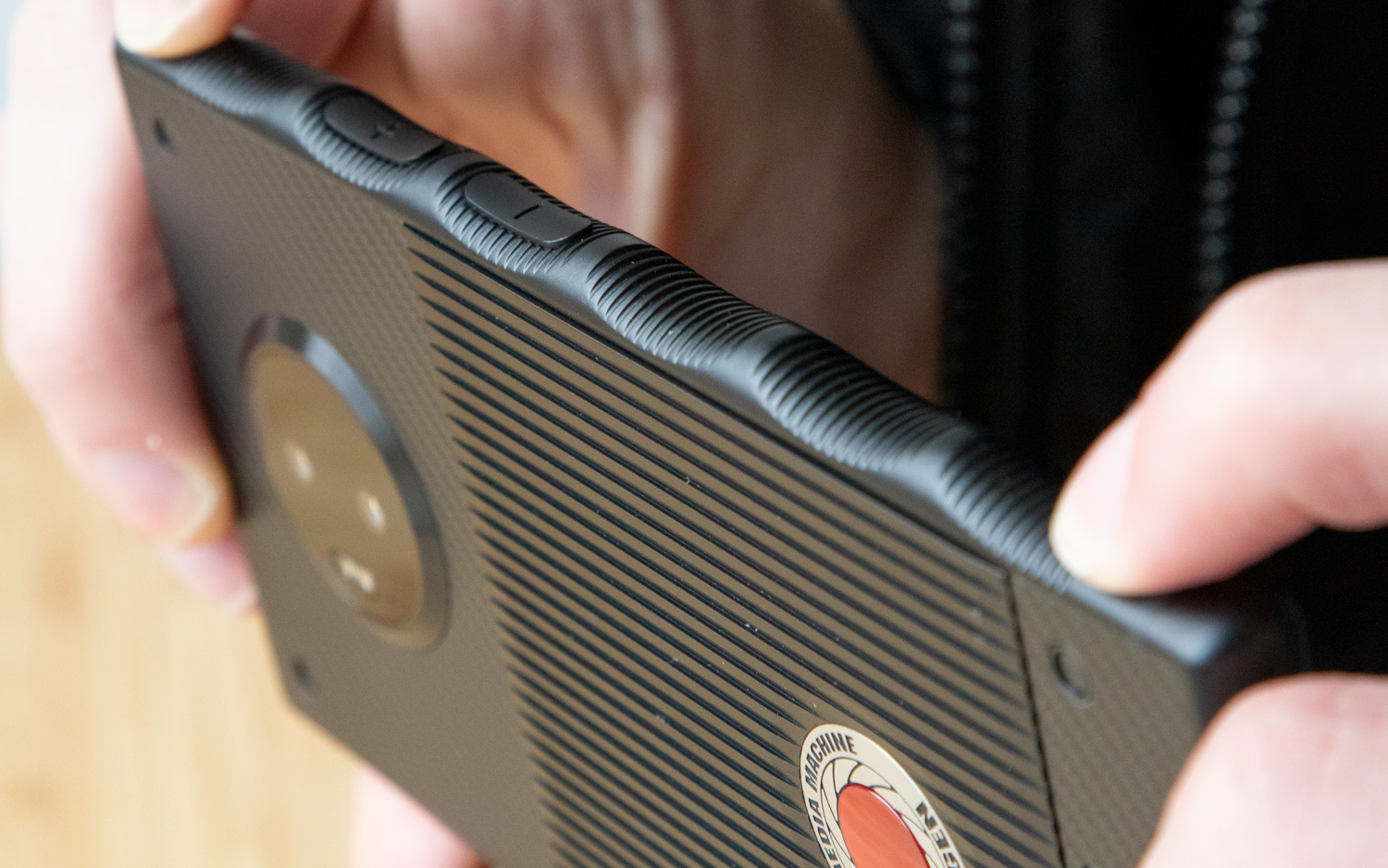
Not even the iPhone XS Max or Galaxy Note 9 delivered that kind of longevity, shutting down after 10:38 and 11:26, respectively.
While it's encouraging that you won't need to charge the Hydrogen One as often as some other phones, a lack of support for wireless charging makes it a little less convenient when you do have to top up.
MORE: Smartphones with the Longest Battery Life
Then again, most other phones aren't clad in Kevlar and aluminum (or titanium) — so that's a trade-off some might be willing to entertain.
Software: Surprisingly stock
Underneath that intimidating exterior, the Hydrogen One actually runs a fairly stock version of Android 8.1 Oreo, with light customization pertaining to the launcher, camera interface and a sprinkling of bloatware.
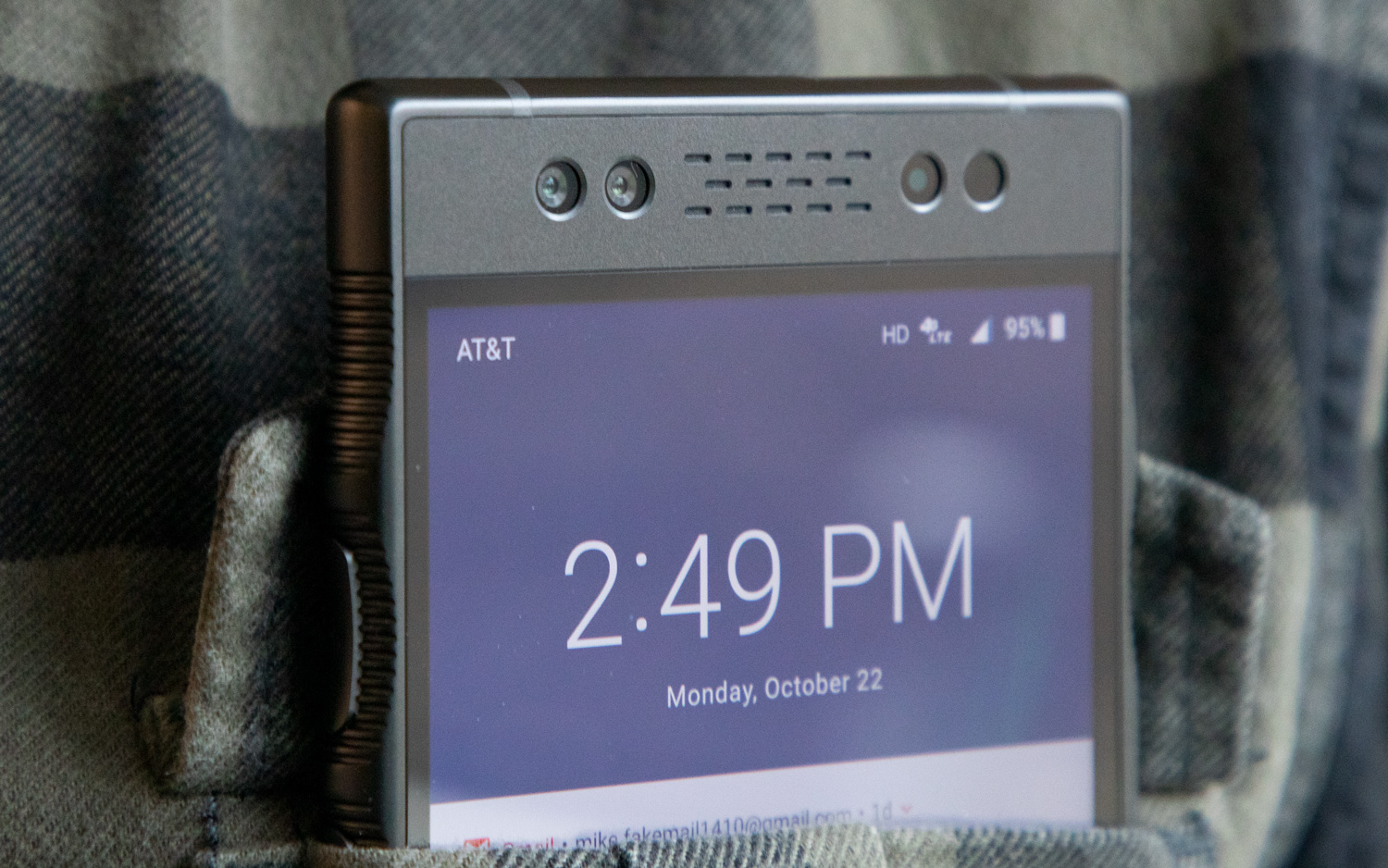
Some of the added software is welcome, like the Hydrogen Network, Leia Loft and Red Player. These are the only ways you can access 4-view content on the device, so disabling them would defeat the purpose of owning the phone. In fact, 4-view photos and videos are visible only through the Red Player, and not Google Photos. That behavior is especially odd, considering the camera app defaults to Google Photos when you scroll back to view your last-taken shot — but only if your last-taken shot was a 2D one.
Rarely have I been so conflicted by a device as I have with Red's very first smartphone.
Aside from Red's software, our AT&T-tied phone came preloaded with a suite of the carrier's apps. We could have done without the DirecTV app, though, thankfully, everything you don't want can easily be disabled, and unlocked models surely won't include any of that. Additionally, if you're put off by the rather garish black-and-silver industrial theme that the phone boots with, you can opt for a more classic Android look and feel through the launcher's settings.
Red tells us the Hydrogen One will receive an update to Android 9 Pie in the near future, though it hasn’t shared any specifics to date.
Bottom Line
Rarely have I been so conflicted by a device as I have with Red's very first smartphone. The Hydrogen One is an ambitious device that so desperately wants to change your life. And every now and then, when the display strikes your eyes at just the precise angle, you feel fleeting glimmers of the magic.
However, Red is working with technology that simply hasn't been perfected yet. Truly immersive glasses-free 3D with zero concessions for comfort and quality is still something of a pipe dream. And, judging from the number of my co-workers who have played with the device over the past week, there's no guarantee that Red's particular brand of 3D will be satisfying or stress-free for your eyes.
If you're intrigued by what the Hydrogen One promises, the best course of action is to visit an AT&T or Verizon store and see the phone running 4-view content in person. Even then, you're faced with an important question: Does the excitement of 3D justify all of the Hydrogen One's myriad quirks, spec deficiencies and high price? Right now, I'm not convinced it does.
Credit: Tom's Guide
Adam Ismail is a staff writer at Jalopnik and previously worked on Tom's Guide covering smartphones, car tech and gaming. His love for all things mobile began with the original Motorola Droid; since then he’s owned a variety of Android and iOS-powered handsets, refusing to stay loyal to one platform. His work has also appeared on Digital Trends and GTPlanet. When he’s not fiddling with the latest devices, he’s at an indie pop show, recording a podcast or playing Sega Dreamcast.
